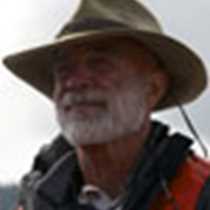George Island and the Inian Islands
It was a cool and drizzly morning as the National Geographic Sea Lion headed through South Inian Passage toward George Island, our destination for the morning. Even before our early morning wake up call, earlybirds on deck were rewarded with some wondrously close looks at an adult humpback whale spouting and throwing its flukes as it dove into the murky depths. George Island is actually located in the Gulf of Alaska, although just barely, and is thus a wonderful place to see seabirds and rugged, exposed shoreline from kayaks, as well as take hikes in the interior. It is also the site of a gun emplacement that was setup early in WWII to protect the Inland Passage from encroachment by Japanese warships. Off and on, sun breaks replaced the clouds and drizzle and we had a great time exploring the forests, beaches, historic sites and marine environment of this interesting little island.
We only moved a few miles during lunch to our afternoon anchorage along South Inian Passage and spent the rest of the day in our Zodiacs exploring the waterways among the Inian Islands. This is an absolute favorite of all the natural history staff because of the abundance and diversity of wildlife along with the incredibly beautiful scenery. The tide was flooding all afternoon, which creates fast currents, big eddies and whirlpools and exciting rides. Steller sea lions and sea otters were the biggest hits. ‘Stellers’ are huge animals with adult males weighing in at over 2,000 pounds (a big California sea lion will weigh only 800 pounds). We saw a number of the really big guys both in the water and on the land, and they were amazingly graceful and at home in both places. We also saw a lot of younger sea lions that were probably all males but it is impossible to tell from a distance until they are at least 4 years old when the males fill out and show their characteristic ‘lion’s mane’. Many sea lions were feeding in the turbulent currents and we saw some thrashing about in order to break down big salmon and halibut into more bite-sized pieces. We also saw quite a few sea otters along the rugged shoreline. Some were preening, others were just swimming along and some were eating clams, crabs or urchins with their dainty little fore paws. They have to eat about 25% of their body weight each day to support a high metabolism that keeps them warm enough to function. Everyone falls in love with these cute little bundles of fur (about 300,000 hairs per square inch!) and perhaps forget that they are members of the weasel family….and act like it! There were also lots of bald eagles and seabirds to round out our afternoon excursions and everyone was abuzz at recap with stories to tell of their day’s adventures.




